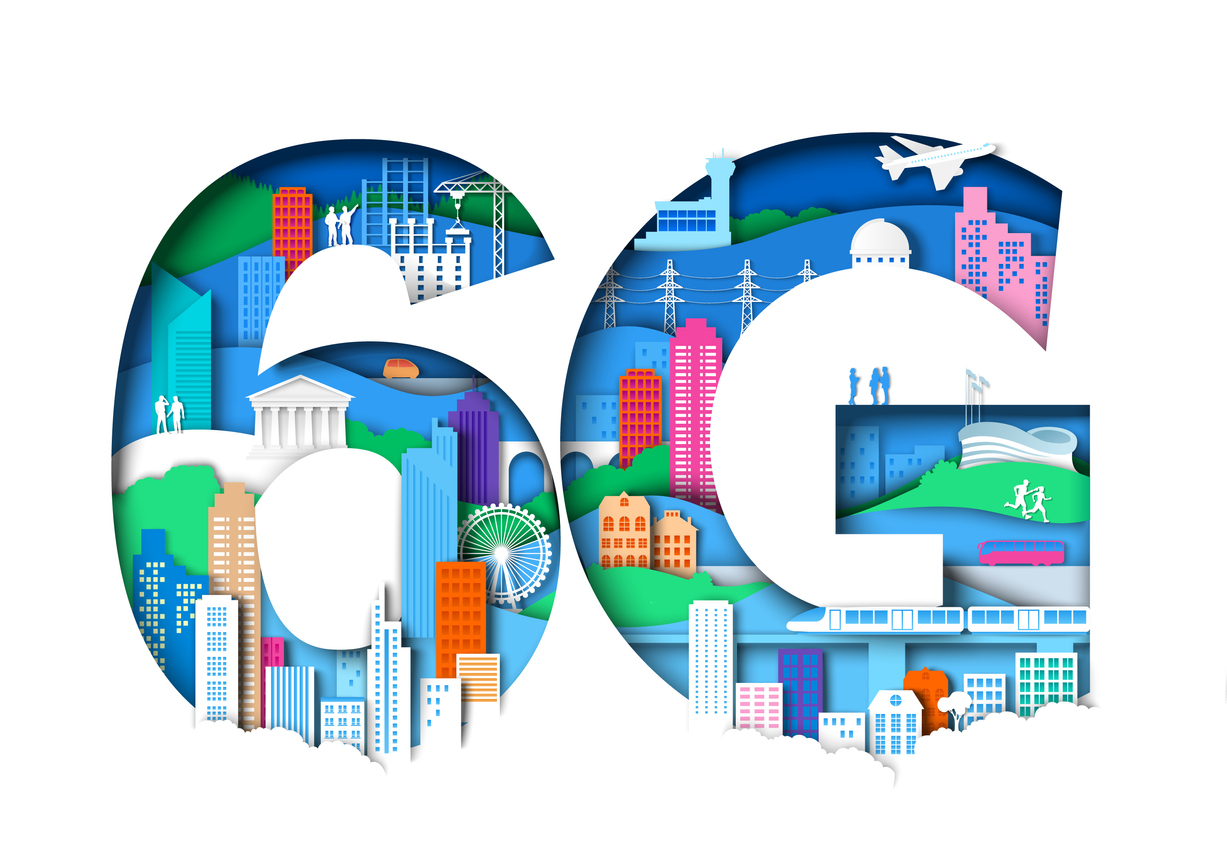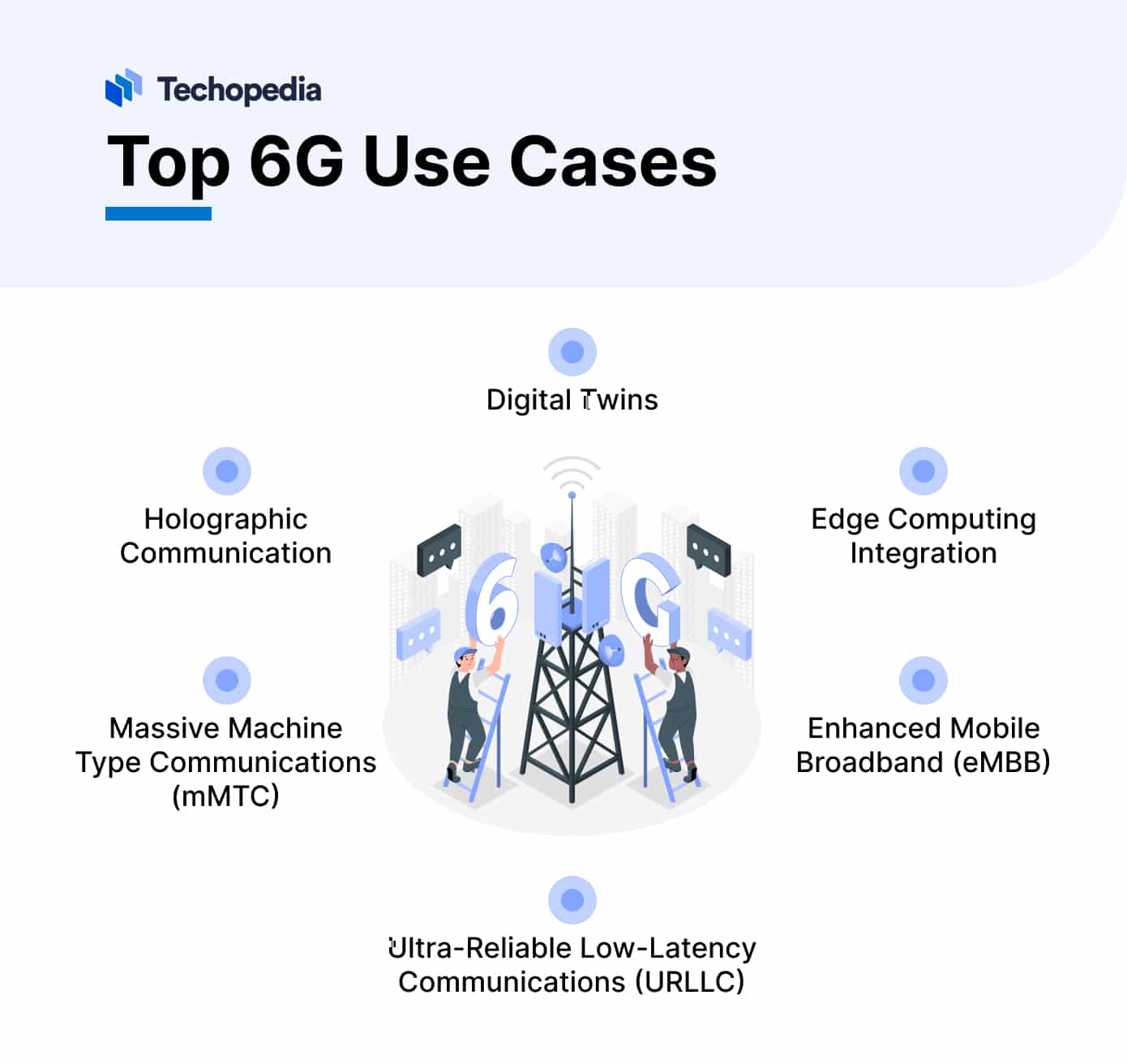The telecommunications sector is rapidly advancing. Although 5G is just beginning its journey, it is expected to have extensive growth potential. By 2025, it could account for as many as 1.2 billion connections, covering one-third of the world’s population.
Even though 5G networks are still being rolled out, anticipation for its successor, 6G, is growing.
6G technology, expected around 2030, promises to dramatically enhance connectivity with theoretical speeds up to 1Tbps and ultra-low latency. This advancement will support transformative applications like autonomous vehicles, remote surgery, and immersive virtual experiences.
Millimeter wave frequencies for near-instantaneous data transfer and adaptive beamforming for efficient signal directionality are key innovations driving the development of this next-generation network.
So, what’s the future of 6G networks?
Key Takeaways
- 6G network’s speed of up to 1Tbps and ultra-low latency significantly outperform current networks and enable applications like autonomous vehicles and remote surgery.
- Key innovations for 6G include millimeter wave frequencies for fast data transfer and adaptive beamforming for efficient signal directionality.
- Advanced telecommunications, such as telemedicine and autonomous transportation, will benefit from 6G’s faster response times and enhanced capabilities.
- Increased device connections in 6G raise cybersecurity concerns and supply chain vulnerabilities, requiring rigorous testing of new protocols.
- Global 6G coverage requires new infrastructure, including low-Earth orbit satellites, to ensure worldwide connectivity even in underserved areas.
- The rollout of 6 G technology is expected around 2030.
- Show Full Guide
Communications Revolution: Potential 6G Use Cases
With ultra-low latency in the order of microseconds, 6G technology is anticipated to support applications such as autonomous vehicles, remote surgery, advanced industrial automation, mixed reality (MR), virtual reality (VR), and augmented reality (AR). Achieving such rapid communication speeds will transform connectivity and enable immediate data transmission and response times.
Star Trek, like holographic communication, is one of the innovative features of 6G technology that is expected to transform how we interact and communicate.
With 6G, advancements in holographic communication will enable realistic and immersive experiences, allowing users to engage in virtual meetings, presentations, and collaborations as if they were physically present in the exact location.
This technology has the innovative power to boost various industries, including entertainment, education, healthcare, and business, by providing a new dimension of communication and interaction.
6G is the next generation of mobile network standards, succeeding 5G. It aims to connect physical and virtual worlds via faster machine-to-machine (M2M) communication and immersive tech support through higher frequencies.
This results in increased bandwidth and lower latency, enabling advanced technologies with enhanced reliability and speed in wireless communication. It also paves the way for innovative applications and services while building on 5G advancements in network infrastructure development.
Top 6G Applications
With the advent of 6G networks come exciting new possibilities and applications. Here are some top anticipated applications for 6G:
- Enhanced Mobile Broadband (eMBB): In a 6G context, eMBB technology enhanced by 5G capabilities will provide significantly faster data speeds and more reliable connections. This development could further transform streaming services, enabling universal access to ultra-high-definition content.
- Ultra-Reliable Low-Latency Communications (URLLC): URLLC is crucial for time-sensitive applications like remote surgery and autonomous vehicles. It provides the ultra-low latency necessary for real-time feedback and ensures the efficiency of safety-critical systems.
- Massive Machine Type Communications (mMTC): The expansion of IoT into sectors like IIoT, smart cities, infrastructure, and agriculture technology highlights the growing importance of mMTC. This approach aims to efficiently connect numerous devices while preventing network overload – a key factor in IIoT’s future success.
- Holographic Communication: Holographic telepresence is a futuristic application linked to high-speed networks. It enables high-resolution, 3D video conferencing that creates the illusion of physical presence despite distance.
- Edge Computing Integration: Edge computing in network architecture allows data processing near its source rather than on centralized servers. This has significant implications for AI analytics and decision-making in healthcare and automotive industries (integrating edge computing into network architecture).
- Digital Twins: A digital twin is a virtual model of a physical entity (e.g., product or ecosystem), utilizing sensor data, predictive modeling, and advanced networking technologies to simulate scenarios, optimize operations, cut costs, and enhance efficiency in real-life environments.
6G Network Release Date
While 5G networks continue to be deployed and expanded globally, 6G is still in the early stages of applied research and technology trials, with an expected release date of around 2030.
This timeline allows for sufficient development and testing of the technology, ensuring its readiness for widespread deployment.
As we move closer to 2030, further advancements and breakthroughs in 6G technology are expected to shape the future of wireless communications.
It’s important to note that the timeline for commercialization and widespread deployment of 6G may vary depending on the research and development progress as industry players continue to innovate and refine the current 5G technologies.
6G vs. 5G. vs. 4G
While 5G technology represents a significant leap forward in wireless communication, including the current 4G network in transition, 6G networks are expected to build upon and enhance the capabilities of 5G.
By operating on higher radio frequencies and leveraging technological advancements, 6G networks will offer even faster speeds, lower latency, enhanced reliability, and pioneering capabilities.
The transition from 5G to 6G, with 4G bridging the gap, will bring about a new era of wireless communication, enabling a wide range of innovative applications and services.
Comparing 4G, 5G, and 6G
| Feature | 4G LTE | 5G | 6G (Expected) |
| Deployment | Widely deployed worldwide | Rolling out globally | Expected around 2030 |
| Data Rate | Up to 1 Gbps | Up to 10 Gbps | Up to 1 Tbps |
| Latency | 20-50 milliseconds | 1-10 milliseconds | Sub-millisecond |
| Frequency Bands | 600 MHz to 2.5 GHz | 24-100 GHz (including mmWave) | Terahertz (THz) bands |
| Bandwidth | 20 MHz | Up to 800 MHz | Up to several GHz |
| Network Capacity | Limited | 10x more capacity than 4G | 100x more capacity than 5G |
| Spectrum Efficiency | Moderate | High | Extremely high |
| Energy Efficiency | Moderate | Improved over 4G | Highly optimized |
| Connection Density | Up to 100,000 devices/km² | Up to 1 million devices/km² | Up to 10 million devices/km² |
| Mobility Support | Up to 350 km/h | Up to 500 km/h | Enhanced mobility support |
| Use Cases | Mobile internet, video streaming | Enhanced mobile broadband, IoT, AR/VR | Advanced IoT, holographic communications, AI-driven services |
| Core Technologies | OFDMA, MIMO | Massive MIMO, beamforming, network slicing | Advanced AI, machine learning, quantum communication |
| Security | Basic encryption, network security | Enhanced encryption, network slicing, secure boot | Advanced quantum cryptography, enhanced AI-driven security |
| Infrastructure | Macrocells, small cells | Macrocells, small cells, mmWave cells | Ubiquitous intelligent surfaces, reconfigurable intelligent surfaces |
Major Players in the Industry
Several major players in the telecommunications industry are actively involved in the research and development of 6G network technologies.
These include well-established companies such as Ericsson, Nokia, Huawei, Samsung, and Qualcomm.
Their expertise, resources, and investments contribute to the advancement of 6G technologies and play a significant role in the future of wireless communications.
6G Telecom Networks: Lightning-Fast Connectivity & Boundless Possibilities
6G networks represent the next generation of cellular technology, designed to provide even faster network speeds, lower latency, and greater capacity than 5G — an anticipated improvement of 1000x.
Theoretically, this means more efficient and reliable communication between devices and systems, opening up many possibilities.
However, future technologies must transcend novelty by offering practical solutions that meet real-world needs across sectors like manufacturing, healthcare, and education, leading to meaningful societal advancement.
Imagine doctors performing remote surgeries with zero lag time or commuters enjoying seamless virtual reality experiences during their daily travels — all thanks to lightning-fast 6G connectivity.
Here are some ways different sectors can benefit from 6G:
Telemedicine will reach new heights with real-time remote consultations becoming commonplace thanks to reduced latency provided by 6G networks. Imagine having instant access to specialists no matter where you live, potentially removing the pressure on local GP clinics.
Autonomous vehicles will become safer, with quicker response times made possible by super-fast 6G connections. Think of smoother rides with fewer accidents on our roads. Not quite Blade Runner or The Fifth Element, but who knows what’s around the corner?
Factories will become more efficient as machines communicate instantaneously with each other on these high-speed networks – leading to increased productivity while reducing wasteful downtime.
Streaming services will offer near-instantaneous loading times, with ultra-high definition video becoming the norm, making your binge-watching sessions even more enjoyable.
Influence of Current Events & Developments
Current events and developments, such as advancements in artificial intelligence, quantum computing, and the Internet of Things, play a significant role in shaping the future of 6G network technologies.
These technological advancements provide the foundation for developing and implementing 6G networks. Furthermore, global trends towards increased connectivity, digital transformation, and the need for faster and more reliable communication further underscore the importance and relevance of 6G internet technologies.
These events and developments will influence the direction and pace of 6G network technology deployment.
6G Network Dangers
6G network testing is edging the world closer to embracing 6G technology, so it’s crucial to recognize and address the inherent risks accompanying this leap forward. Deploying 6G networks brings significant challenges, including heightened cybersecurity threats and privacy issues. Industry experts, policymakers, and researchers must work together proactively to ensure a safe transition towards this next generation of wireless communication.
A recent study published by Researchgate discusses the risks associated with 5G technology, how it opens up more ways for attacks, and why we need top-notch encryption to keep everything safe and sound. The study also explores how the threat scene changes and why we must step up our cybersecurity game to protect important information and critical systems. It also discusses the global competition surrounding the race to deploy and control the technology.
Although precise statistics regarding vulnerabilities specific to 6G are scarce at the moment, lessons learned from previous transitions — like those from 4G to 5G — suggest we could see up to a twofold rise in security incidents during initial deployment phases.
Potential Attack Vectors
- The advent of 5G technology and IoT devices significantly expands the attack surface, increasing network susceptibility to attacks if devices aren’t secure.
- A global supply chain underpins 5G infrastructure, introducing potential risks through compromised hardware or software components.
- Modernized SDN architecture, like virtualization and network slicing, offers flexibility but introduces new vulnerabilities due to complexity and software dependence.
- New protocols and features aiming to improve performance or security may initially have unknown vulnerabilities.
- Edge computing’s decentralization improves speed but exposes sensitive information at multiple points, increasing opportunities for unauthorized access unless adequately protected.
6G Wireless Networks Infrastructure Challenge
Let’s not get carried away because before 6G wireless networks become a reality, developing new infrastructure for the terahertz-powered wireless communications network is crucial.
Prepare for the launch of clusters of low earth orbit (LEO) satellites over the next five to ten years, which will set the ground for a global infrastructure overhaul.
LEO satellites can transform connectivity, facilitating the transfer of ultra-high frequencies from space to ground-level base stations and guaranteeing uninterrupted coverage worldwide.
This groundbreaking technology will benefit even remote rural regions where conventional cellular signals falter.
The Bottom Line
The telecommunications sector is on the brink of a revolutionary leap with the advent of 6G. This technology offers unprecedented speed, lower latency, and radical capabilities that build upon the foundation laid by 5G.
As we edge closer to its expected launch around 2030, 6G’s promise to enhance connectivity and drive innovation in telecommunications is undeniable.
However, navigating the challenges, including cybersecurity threats and privacy concerns, is crucial to ensuring a safe transition towards this next-generation wireless communication.







